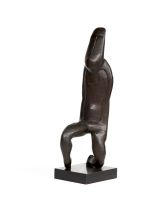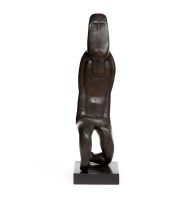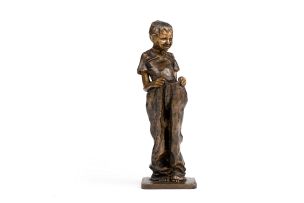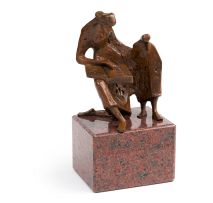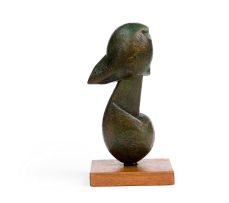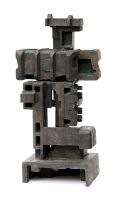Important South African and International Art
Live Auction, 13 November 2017
Session Three
Incl. Buyer's Premium & VAT
About this Item
signed with the artist's initials and numbered I/X
Notes
Sydney Kumalo was a still a teenager when, in 1952, he began attending biweekly art classes at a hall designated for 'non-European' adult recreation on Polly Street in central Johannesburg. Sophiatown-born Kumalo pursued painting, an interest sparked by youthful encounters with paintings and sculptures seen in white suburban homes serviced by his house-painter father. The death of Kumalo's father prompted a sudden transition from watercolour painting to sculpture. His first sculptural work was a ceiling mural at St Peter Claver Church in Seeisoville, Kroonstad, which he executed with his mentor, Cecil Skotnes. Kumalo additionally produced bas-reliefs of the 14 Stations of the Cross, photographs of which Skotnes showed to Edoardo Villa. In 1958 Villa agreed to mentor Kumalo twice a week at his studio.
A figural sculptor interested in synthesising the idioms of West and Central African sculpture with the volumetric experiments and simplifications of the human form by modernist sculptors like Brancusi and Moore, Kumalo's syncretic style gained him great acclaim. In 1962 Kumalo held his debut solo exhibition with Johannesburg dealer Egon Guenther, who further aided Kumalo's early public reception by, from 1963, showing him under the Amadlozi banner with fellow artists Giuseppe Cattaneo, Cecily Sash, Skotnes and Villa (and later Ezrom Legae). His work was included on a group show organised by American dealer Eric Estorick at his Grosvenor Gallery in London. The New York Times discussed the show. After introducing Kumalo as South Africa's 'best-known, most admired and most sought-after figurative sculptor,' the newspaper's critic favourably remarked on the 'powerful monumentality'of Kumalo's works.¹ In 1966 Kumalo represented South Africa at the Venice Biennale.
Kumalo's mature style, of which this is a representative work, is noted for its expressive figuration and preference for stippled and/or lacerated surface finishes. His output included both human and animal subjects. Kumalo would sometimes show his human subjects as sitting or crouching; while anatomically awkward, these distorted portrayals of the human figure were nonetheless meant to suggest reverence and devotion. The mood in these peak-career works, noted poet and critic Lola Watter in 1968, 'is one of intense contemplation'.²
Many thanks to Mr Gerard de Kamper, Chief Curator of Museums at the University of Pretoria, for identifying this lot.
1 Anon. (1965) 'Art under apartheid', New York Times Magazine, 28 March.
2 Lola Watter. (1968) 'Sydney Kumalo: Sculptor', Lantern, September,
page 42.
An additional note from Gavin Watkins:
In what many regard as Kumalo's golden period, from 1966 to 1968 Kumalo produced a number of sculptures under Egon Guenther's tutelage in a series which has been labelled his 'Madala series'. A precursor to the series is the wonderfully evocative sculpture High Shoulders (conceived in 1966) with the powerful large sculptures Pregnant Woman II and The Listener following immediately thereafter in 1968. There are eight Madala figures in the series (Madala I to Madala VII and Happy Madala), conceived in 1966 (Madala I), 1967 (Madala II, III, IV, V, VI and VII) and 1968 (Happy Madala). Egon Guenther cast only one or two editions of each of these sculptures so they are very rare (it is worth noting that Linda Goodman cast a small edition of Madala II and Madala IV in 1976).
The present lot, Madala VI, is a particularly striking example from the Madala series. In the absence of any photographic records of this work, until recently this sculpture was known only from Egon Guenther's records and from Susanna Jansen van Rensburg's thesis Sydney Kumalo en ander bantoekunstenaars van Transvaal (University of Pretoria, 1970). The face of Madala VI is however familiar because the upper half of the body of Madala VI was recast by Linda Goodman in the early 1990s as a new sculpture which she titled The Patriarch. Discovering Madala VI in its original form is a rare find indeed.
Provenance
Acquired directly from Egon Guenther in 1967.

